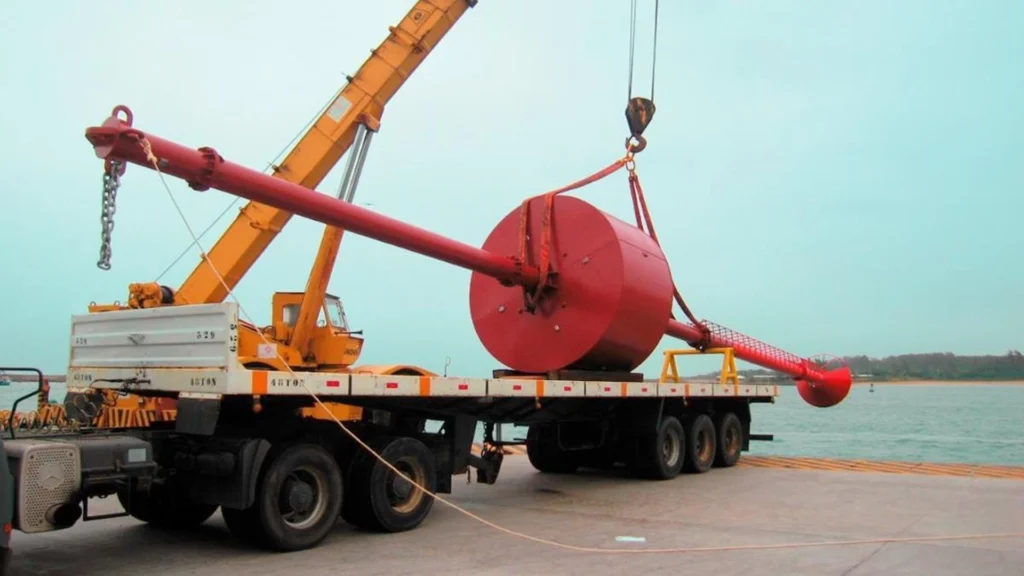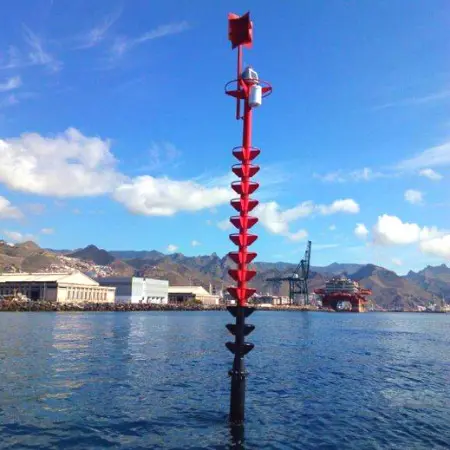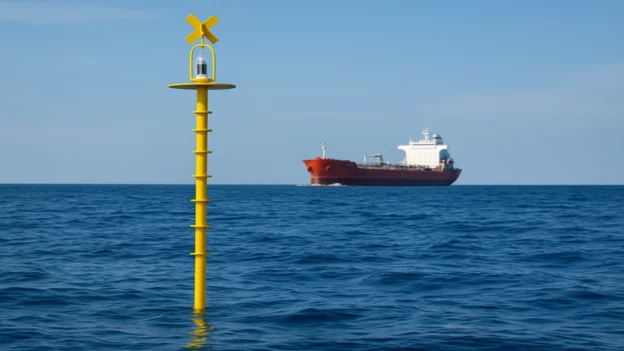Table of Contents
- The design that redefines floating signage
- The versatility of articulated buoys and their applications
- Difference from monobuoys: Strategic functions
- Role of IALA regulations
- Products, technologies, and stability analysis
- Life Cycle Cost Optimization (LCCA)
- Conclusion
- References
- Frequently Asked Questions (FAQs)
In maritime operations, a buoy can mean the difference between safe navigation and operational risk. Articulated buoys represent an innovation that improves the stability of floating aids, reducing maintenance and ensuring accurate signaling in the most demanding conditions.
This issue is highly relevant for the coastal energy sector and maritime terminals, and will be one of the highlights of the upcoming SLOM 2025 conference, where experiences and innovations in maritime safety will be presented.
The design that redefines floating signage
Unlike conventional buoys, an articulated buoy is a floating structure attached to a fixed point on the seabed by an articulated joint (or gimbal joint). This system eliminates the oscillations and wide radius of drift of traditional buoys with mooring lines, maintaining an almost static position.
Its design prioritizes vertical stability, which is necessary for the visibility of the lantern and radar reflector, even in rough seas or strong currents. The integration of submerged floats reinforces stability, limiting the angle of heel and ensuring that daytime and luminous markings comply with regulations.

The versatility of articulated buoys and their applications
Articulated buoy technology is not limited to a single design. There are a variety of configurations that can be adapted to the specific needs of the marine environment. Among the most common are the pole or articulated pillar types, which are ideal for narrow navigation channels and port areas, as their slender design maintains a stable focal plane in confined spaces.
On the other hand, spar buoys are recommended for environments with moderate waves, where their elongated and slender design improves dynamic response to waves and reduces the radius of gyration. Finally, reinforced modular buoys are used in areas with strong currents or extreme tides, with segmented structures that facilitate quick replacement of parts and better withstand dynamic loads.
In configurations such as the pole (ASBM), the modular design even allows for telescopic adjustment of the “tail” according to the draft and focal height required, demonstrating the flexibility of this technology to ensure mark legibility and focal plane accuracy on fairways with significant environmental conditions.

Difference from monobuoys: Strategic functions
A common mistake is to confuse an articulated buoy with a single buoy. Although both are floating structures, their functions are fundamentally different. Single buoys are mooring systems for loading and unloading hydrocarbons. They are designed to transfer crude oil through a riser/amantillo and hoses, with 360-degree freedom of movement to reduce operational stresses.
In contrast, articulated buoys are navigational aids designed for precision; their purpose is to mark channels and fairways, acting as fixed and reliable reference points required for the safety of maritime traffic.
Role of IALA regulations
The success of navigation channel signage depends on strict compliance with the standards of the International Association of Marine Aids to Navigation and Lighthouse Authorities (IALA). Articulated buoys must adhere to these guidelines for lateral, cardinal, or safe water markings. The inherent stability of these buoys ensures that the chromaticity, shape, and rhythm of light remain constant, allowing ships to correctly identify the channel and avoid hazards, a fundamental requirement for maritime safety.
Products, technologies, and stability analysis
Innovation in the design of articulated buoys is constant. Manufacturers have introduced configurations such as pole and modular designs, which allow damaged components to be replaced without removing the entire structure. Composite materials and rotomolded plastics have replaced traditional metals, reducing weight, increasing durability, and combating corrosion and fouling. Cathodic protection with sacrificial anodes is vital for metal parts.
Stability analysis is a mandatory step in the design process. Simulations of environmental loads from wind, waves, and currents are performed to ensure that the buoy returns to its vertical position. The mooring line is designed with precision, evaluating the strength of chains, shackles, and elasticity to prevent premature fatigue.
The latest technologies incorporate IoT sensors to monitor anchor inclination and tension in real time, enabling predictive maintenance, optimizing responsiveness, and reducing operating costs.
To enhance safety and detection, passive radar reflectors (≈10 m² RCS) are integrated, in addition to solar modules and battery housing in a basket. These elements improve the buoy’s visibility and ensure its energy autonomy in continuous operation.
Life Cycle Cost Optimization (LCCA)
Life Cycle Cost Analysis (LCCA) demonstrates that, despite a potentially higher initial investment (CAPEX), the long-term cost of articulated buoys is considerably lower. This economic advantage is due to reduced structural maintenance requirements, longer service life, and reduced IMR operations.
A strict inspection plan that includes checking the articulated joint, the condition of the anodes, and the power modules ensures high operational availability and a profitable investment over time.
Conclusion
Articulated buoys represent a strategic technical evolution for maritime safety in maritime terminals and navigation channels. Their precise design, integration with monitoring technologies, and favorable LCCA make them a key solution for optimizing operations and safety. Adopting this innovation is a technological improvement and a commitment to efficiency and safety. To learn more about these solutions and the future challenges facing the sector, we invite you to discover more at the upcoming SLOM 2025 conference.
References
- International Organization for Marine Aids to Navigation. (n. d.). Retrieved from https://www.iala.int/
- ASBM Boya Articulada o Tipo Pilar. (n. d.). En Scribd. Retrieved from https://es.scribd.com/document/900683823/ASBM-Boya-Articulada-o-Tipo-Pilar
Frequently Asked Questions (FAQs)
When should you choose articulated buoys over fixed buoys?
When the environment presents waves, currents, or space limitations that compromise the stability of a fixed buoy.
What is the average lifespan of an articulated buoy?
It is usually in the range of 10–15 years, depending on materials and coatings, environmental severity (waves, currents, fouling), and the rigor of the IMR plan. With preventive inspection, repainting, and anode replacement, it is possible to extend this period while maintaining reliability.
Does your signage comply with IALA (lateral, cardinal, safe water)?
It must be verified that colors, stop marks, and light rhythms comply with IALA regulations in each region.
How do you plan the IMR and service life of each buoy?
Through periodic structural inspections, scheduled maintenance, and estimation of useful life based on fatigue and corrosion.
What advantages do they offer over single mooring buoys?
Articulated buoys ensure stable signaling in channels and fairways, while single buoys focus on hydrocarbon transfer operations.

